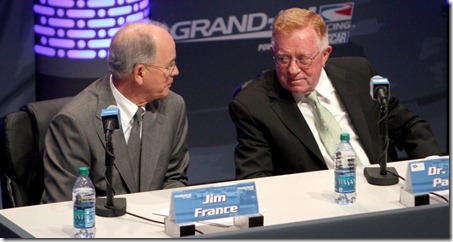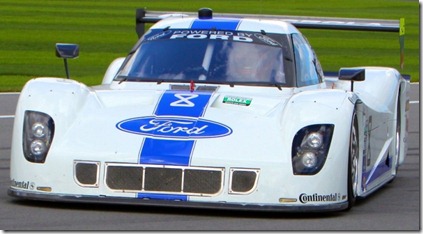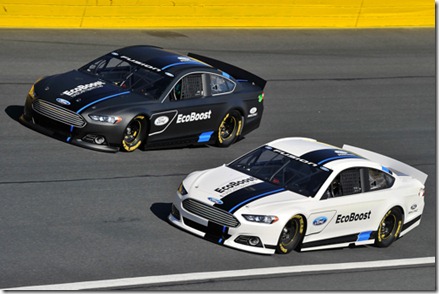KANSAS CITY – "They've got some crazy little women there . . ."
Beg your pardon, but continued resistance to the temptation of reciting one of the all-time-great song lyrics/tunes was ultimately beyond your humble scribe's capacity.
Had the September meeting of the minds between Mr. James France and Dr. Don Panoz (respectively, at left) not occurred, the Kansas Speedway test now past likely would've allowed everyone's first look at the Ford EVOS EcoBoost V6 Daytona Prototype.
Alas, just because a couple of guys got together and decided the two major North American sportscar series was just two too many (think about it) ardent Ford fans everywhere are again left pining for the good ol' days when the carmaker dominated endurance races like the Rolex 24 At Daytona . . . um, uh, er, just as it had earlier this year in the race's Golden edition.
Okay, so a Ford can still dominate, as did Michael Shank Racing, Ozz Negri, John Pew, A.J. Allmendinger and Justin Wilson prove at the 2012 Rolex 24 at Daytona.
Yet with all due respect to the boys (hmmm, one wonders the number of women on the production or R&D floors) back at Roush Yates Engines, a Rolex Series DP engine wasn't ever quite enough "identity" for the boys back at Dearborn, who both loved and cringed at the sight of the Ford oval on the front of Starworks' DP (at right) and with the 2012 season's advance would mysteriously disappear.
When asked the relative importance of a race car's cornering ability versus that of an engine, the teacher of great-racer teachers, Terry Lee Earwood, replied (over 3 nanosecond's time), "I'll take horsepower any day. It's a racer's best friend."
Thus, a fellow whose blackboard mantra generally was confined to five words – "turn in, apex, track out" – still wished for "more power."
However, when not in the seat and viewing from afar – where most fans find themselves – the shape of a car, not an engine's power or, for that matter, its sound (Doppler Effect), allows the easiest, most-often-correct recognition.
INTERSECTING
If, as some say, luck results from the convergence of knowledge, opportunity and awareness then Grand-Am's rules makers were all over it in the spring of 2011 when begun anew was the second of the every-now-and-again rules evolutions promised when the Daytona Prototype concept was publicly unveiled in January 2002.
With an updated DPG3 on the 2012 racing horizon, Grand-Am's upper management were soon calling upon GM and Ford for exploratory discussions on the shape of things to come. (Remember the song, perchance? Mike Curb produced it. Yep, THAT Mike Curb.)
Those at GM/Chevrolet/Corvette divisions were totally okay with joining the Daytona Prototype's ranks so long as "their" car bore certain visual styling prompts that when appearing together unquestionably communicated "Corvette."
At about the same time as Chevrolet began its massive breakneck effort (beginning late-spring 2011) "Ford" was likewise given the same opportunity but it declined for reasons, at the time kept close to the Blue Oval's vest, that later (and later herein) became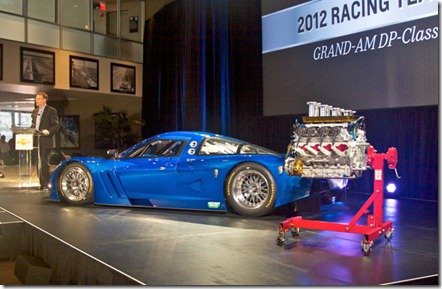 clear.
clear.
As males everywhere possessing sufficient testosterone will display, if not personally attest (and women everywhere flat-out know), a simple challenge of male ego often is in and of itself enough to spur testos . . . er, competition – as has clearly happened often enough over the last 60-or-so years in North American sportscar racing.
Indeed, the official Ford story of Ford Motor Company's founding being directly tied to a bet arising from racing is indisputable, but it's highly likely that Henry "The Original" Ford's testosterone also played a role, too.
It's safe to say "considerable" was the media impact of the Corvette Daytona Prototype's December 2011 introduction at Daytona International Speedway's Daytona 500 Club. (above)
SWITCHING GEARS
Other than the Ford Muckety Mucks theirownselves, what or who pushed them over the top is a matter of conjecture to the rest of us down-the-food-chain types, but react they did.
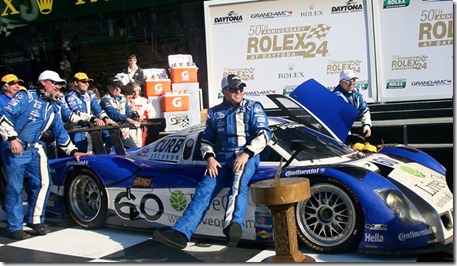 Heck, it could've even been that big blue Ford Oval on the front of Starworks' second-place 50th Rolex 24 At Daytona car or, finishing ahead of it in first place, was a nicely liveried but nevertheless plain-Jane, vanilla-flavored Riley (no disrespect intended, Mr. and Mr. Riley) out of Mike Shank's Pataskala, Ohio, race shop. (at left, Shank on sidepod)
Heck, it could've even been that big blue Ford Oval on the front of Starworks' second-place 50th Rolex 24 At Daytona car or, finishing ahead of it in first place, was a nicely liveried but nevertheless plain-Jane, vanilla-flavored Riley (no disrespect intended, Mr. and Mr. Riley) out of Mike Shank's Pataskala, Ohio, race shop. (at left, Shank on sidepod)
Concluding a Rolex 24 dry spell lasting since its 2003 Daytona Prototype class win (Multimatic Ford Focus DP), its engine-powered 1999 overall win (Dyson Ford-R&S Mk III) and, 45 races beforehand (count 'em; all of 'em), the Shelby American all-Ford Mk II (no, it wasn't a "Lola") win, Ford after the 2012 victory got some well-deserved credit after paying some serious dues in the 2009 Rolex 24.
Somebody internally at Ford must've then wondered: "If we can get this kind of PR after a privateer took disparate parts and won, what if ?" because by the following summer squeezed onto the already well-crowded space of Ford aerodynamicist Bernie Marcus' drawing board was a Ford DP blank sheet. (And, yes, Marcus still draws his designs with graphite in hand, as also does the elder of the two aforementioned Riley chaps.)
As did his counterparts at GM rely on cues taken from an iconic GM product, German-native Marcus (who as a snot-nosed kid partially designed the ducting on the famed March 83G) likewise borrowed the looks of a Ford-crafted icon, only it wasn't the longstanding iconic "Mustang" expected by just about everyone in the 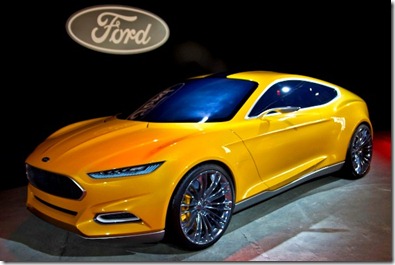 universe.
universe.
Instead, chosen as the DP styling model was a slightly newer Ford icon – the Ford of Europe, Stefan Lamm-designed Ford EVOS. (right)
FUSION' IT TOGETHER
Known internally as the Kinetic 2.0, the hybrid EVOS wasn't so much about Ford's "future" as it was the "near-term," as exemplified by the 2013 Ford Fusion whose design elements clearly are shared with the EVOS.
Indeed, expect to see EVOS design aspects arise throughout the Ford vehicle lineup over the next model year or so, as it was even in the company's version of its NASCAR Sprint Cup competitor for 2013, the Ford Fusion EcoBoost race car. (below)
In a loaded comment made along with the 2013 Ford Fusion's NASCAR introduction – that for most listeners went in one ear and out the other – Ford Racing director Jamie Allison's "We are very excited about what is upon us for 2013,” went well beyond the then-presently obvious.
ADD ECOBOOST
Extending Ford's ever-growing EcoBoost "green" powerplant theme in Grand-Am from its Continental Tire Sports Car Challenge series' Ford Focus ST-R with EcoBoost (fielded by Multimatic Motorsports; driven by James Gué, Gunnar Jeannette, below), destined for the "EVOS DP" was a turbocharged V-6 developed by Roush Yates Engines in Mooresville, N.C.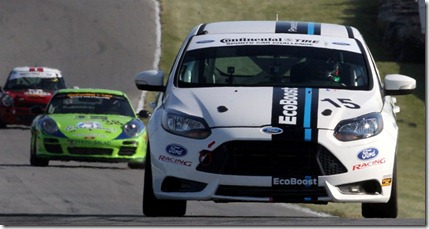
An iteration of RYE's Project Libra, a Ford-based EcoBoost 3.2-liter V6 turbocharged engine was destined to occupy Ford's Daytona Prototype engine bay.
At Allison's direction, Marcus' infusion of EVOS elements into the Ford DP design along with The Boys In Marketing's nomenclatural EcoBoost was at the least a well conceived, well coordinated rolling billboard campaign that would have cut a broad swath across North America's racing series (wanna bet there isn't something afoot for the NHRA's Team Ford Racing, too?).
When a Grand-Am decision to "hold" (read: "altogether stop") the Ford DP project a week after Dr. Don Panoz sold the ALMS lock, stock, tracks and hotels to Mr. James France, it's little wonder Ford's Allison blew two sets of Ford Racing Pro Stock Mirror-Image Head Gaskets (part no. M-6051-JC501).
Then again, what's another $900 when burnt were million-dollar Ford design, research and development chips?
And THAT, folks, seems to be about as much a part of racing as is racing. It wasn’t the first; won’t be the last. Though it could darn well be Allison’s.
THE GOOD NEWS:
Born today in radically different years, um, decades were Elliott Forbes-Robinson and Michael "Rocky" Rockenfeller – both Rolex 24 At Daytona winners and neither of whom yours truly would bet against, regardless of age – even against each other.
Later,
DC
